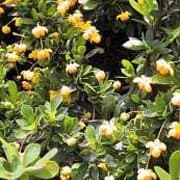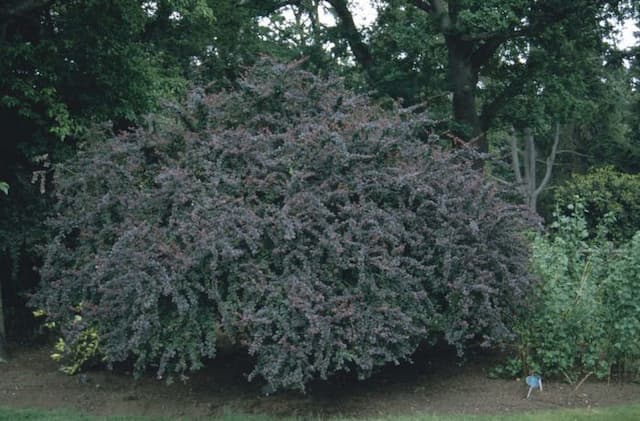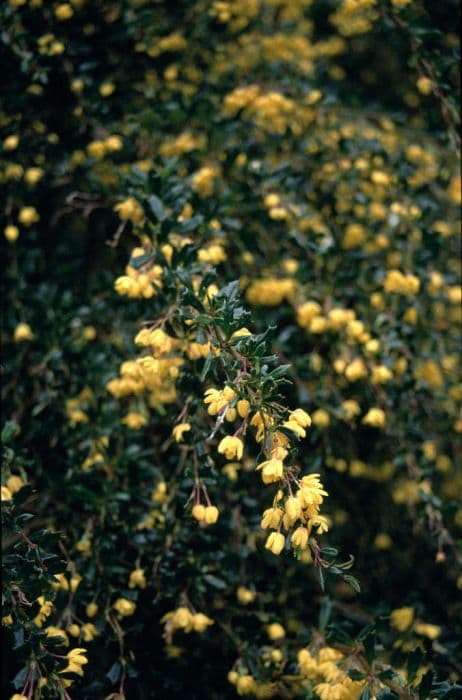Darwin's Barberry Berberis darwinii

ABOUT
Berberis darwinii, commonly known as Darwin's Barberry, bears a striking appearance characterized by its spiny, evergreen leaves, which are small and holly-like with a glossy, dark green color. The leaves grow in clusters, providing a dense, rich texture. In spring, this plant becomes even more spectacular with the addition of vivid orange flowers that hang in abundant clusters, attracting pollinators. These flowers eventually give way to small, blue-black berries that are favored by birds and wildlife. The stems of Darwin's Barberry are often arching, with the spines providing a defensive mechanism against browsing animals. The intricate interplay of its dense foliage, bright flowers, and dark berries against the thorny branches creates a striking visual contrast that adds interest to any garden or landscape where it is planted.
About this plant
 Names
NamesSynonyms
Darwin's Barberry, Darwin's Berberis, Michay
Common names
Berberis chilensis, Berberis corymbosa, Berberis cumingii.
 Toxicity
ToxicityTo humans
Darwin's barberry is not commonly known to be toxic to humans. However, it is always advisable to be cautious and avoid ingesting plants that are not confirmed to be safe, as individual reactions can vary and there may be a lack of comprehensive research on the plant's effects when consumed.
To pets
Darwin's barberry is also not commonly reported as toxic to pets. However, as with humans, it is best to prevent pets from ingesting this or any unknown plants, as individual animals may have different sensitivities and there may be a lack of detailed scientific information regarding the plant's toxicity in pets.
 Characteristics
CharacteristicsLife cycle
Perennials
Foliage type
Evergreen
Color of leaves
Dark green
Flower color
Yellow-orange
Height
6 feet (1.8 meters)
Spread
7 feet (2.1 meters)
Plant type
Shrub
Hardiness zones
7
Native area
South America
Benefits
 General Benefits
General Benefits- Landscape Ornamentation: Berberis darwinii, commonly known as Darwin's Barberry, provides vibrant color and structure to gardens and landscapes with its holly-like evergreen leaves and striking orange-yellow flowers.
- Wildlife Attraction: The plant produces berries after flowering, which are a valuable food source for birds and other wildlife, enhancing biodiversity.
- Privacy and Security: The thorny nature of Darwin's Barberry makes it an excellent choice for creating secure hedges and natural barriers to deter unwanted access.
- Erosion Control: Its dense root system can help stabilize soil and prevent erosion on slopes or banks.
- Drought Resistance: Once established, Berberis darwinii is quite drought-tolerant, making it suitable for xeriscaping or gardens with low water availability.
- Seasonal Interest: With its evergreen foliage, bright flowers in the spring, and sometimes colorful autumn berries, it provides year-round visual interest in the landscape.
- Low Maintenance: It generally requires minimal care once established, aside from occasional pruning to maintain size and shape.
 Medical Properties
Medical Properties- Antimicrobial: Berberis darwinii contains alkaloids that have been shown to have antimicrobial properties.
- Antioxidant: The plant exhibits antioxidant effects which may be beneficial for preventing oxidative stress-related diseases.
- Anti-inflammatory: There is evidence to suggest Berberis darwinii has anti-inflammatory properties which could be useful in reducing inflammation.
- Analgesic: The alkaloids found in this plant may have pain-relieving properties.
 Air-purifying Qualities
Air-purifying QualitiesThis plant is not specifically known for air purifying qualities.
 Other Uses
Other Uses- Dye Production: Berberis darwinii's bark and roots can be used to produce yellow dye, traditionally utilized in textile coloring.
- Photography: The berries of Berberis darwinii contain berry juice that can be used as a photographic dye for printing photographic images.
- Spiny Barrier: The thorny nature of the plant makes it an effective barrier against small animals and trespassers when planted as a hedge.
- Ornamental Use: In landscaping, Berberis darwinii is prized for its vibrant orange flowers and is often planted to add color to gardens.
- Fish Poison: Some indigenous cultures have used the roots of Berberis darwinii to stun fish, making them easier to catch.
- Tool Handles: The hard wood of Berberis darwinii can be crafted into durable handles for various hand tools.
- Engraving: The wood is also suitable for detailed engraving work due to its fine grain and hardness.
- Winter Interest: The evergreen leaves and persistent berries add visual interest to gardens in the winter months.
- Bird Habitat: Dense thickets of Berberis darwinii provide nesting sites and shelter for various bird species.
- Erosion Control: The plant's extensive root system helps stabilize soil on slopes and prevent erosion.
Interesting Facts
 Feng Shui
Feng ShuiDarwin's Barberry is not used in Feng Shui practice.
 Zodiac Sign Compitability
Zodiac Sign CompitabilityDarwin's Barberry is not used in astrology practice.
 Plant Symbolism
Plant Symbolism- Protection: Berberis darwinii, commonly known as Darwin's Barberry, has sharp thorns, making it a plant often associated with protection and defense. It symbolizes the need to safeguard oneself or something important.
- Resilience: Darwin's Barberry is known for its hardy nature and ability to thrive in various conditions, representing resilience and the ability to overcome adversity.
- Adaptability: This plant can tolerate different environments, symbolizing adaptability and the capacity to adjust to changing circumstances in life.
 Water
WaterDarwin's Barberry should be watered deeply, ensuring that the soil is moist but not waterlogged. During the active growing season in spring and summer, water the plant approximately once a week with about 2 gallons per watering session for an established shrub, depending on the climate and soil drainage. In hotter, dryer periods, you may need to increase watering frequency. During the fall and winter, reduce watering to every other week or less, as the plant requires less moisture when it is not actively growing. Always check the soil moisture before watering; the top inch should be dry to the touch.
 Light
LightDarwin's Barberry thrives best in full sun to partial shade. It should be planted in a spot that receives at least 6 hours of direct sunlight daily, but it can also tolerate some dappled shade, especially in areas with hot afternoon sun. The brightness of the light will influence the flowering and fruiting, with more sun typically leading to a greater abundance of blooms and berries.
 Temperature
TemperatureDarwin's Barberry is hardy and can withstand temperatures as low as 10°F but may suffer damage below this point. It prefers a range between 60°F to 75°F for optimal growth, although it can tolerate higher temperatures if adequate water is provided. The plant is well-suited for temperate climates and can thrive in USDA zones 7 through 9.
 Pruning
PruningDarwin's Barberry benefits from pruning to shape the plant, remove any dead or diseased branches, and encourage new growth. The best time to prune is in late winter or early spring before new growth starts. Pruning can be done annually or as needed to maintain the desired size and shape of the shrub. Always use clean, sharp tools to make precise cuts that will heal quickly.
 Cleaning
CleaningAs needed
 Soil
SoilDarwin's barberry thrives in well-draining soil with a pH ranging from slightly acidic to neutral (pH 5.5-7.5). A mix of loam, peat, and sharp sand in equal parts can create an ideal growing medium.
 Repotting
RepottingDarwin's barberry should be repotted every 2-3 years during its active growth phase to avoid becoming root-bound and to refresh the soil.
 Humidity & Misting
Humidity & MistingDarwin's barberry prefers moderate humidity levels but is quite adaptable and can tolerate a range of humidity conditions typical of outdoor environments.
 Suitable locations
Suitable locationsIndoor
Place in bright light, avoid overwatering, protect from drafts.
Outdoor
Full sun to part shade, well-drained soil, shelter from harsh winds.
Hardiness zone
7-9 USDA
 Life cycle
Life cycleThe life of Darwin's Barberry (Berberis darwinii) begins with seed germination, typically in the spring, where it requires moist, well-draining soil and adequate sunlight. Following germination, the plant enters a juvenile vegetative stage, where it focuses on leaf development and root establishment. As it matures into the adult vegetative stage, it develops thorny branches and evergreen foliage, demonstrating significant growth in both height and spread. The reproductive stage follows, usually in early to mid-spring, when Darwin's Barberry produces clusters of orange-yellow flowers, which are attractive to pollinators like bees and birds. After pollination, these flowers develop into small, blue-purple berries that ripen by late summer or autumn, becoming a food source for birds and aiding in seed dispersal. The plant can live for many years, continuing to grow and produce flowers and fruits annually, with older specimens capable of reaching several meters in height and establishing dense thickets.
 Propogation
PropogationPropogation time
Spring to Summer
The most popular method for propagating Berberis darwinii, commonly known as Darwin's Barberry, is by semi-hardwood cuttings. This technique involves taking cuttings from the current season's growth in late summer, ensuring that each cutting is about 4 to 6 inches (10 to 15 centimeters) long. Strip the lower leaves and dip the cut end in rooting hormone for enhanced rooting success. Plant the cuttings in a well-draining potting medium, keeping them at a consistent moisture level. These cuttings should be placed in indirect sunlight and if possible, under a humidity dome or inside a propagator to retain moisture and encourage rooting. Roots typically develop within several weeks, after which the new plants can gradually acclimatize to outside conditions and then be transplanted to their final growing positions.









